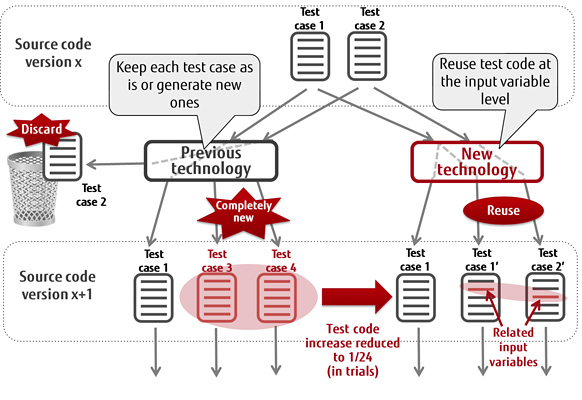Fujitsu Develops Automatic Test-Generation Technologies to Limit Excessive Testing Work in Agile Software Development
Automatic test-generation technologies analyze source code and generate new test cases to exhaustively test software. However, under an agile development approach, frequent, repeated changes to the source code result in a large number of test cases and excessive testing work.
Fujitsu Laboratories have now developed automatic test-generation technologies that can efficiently search for the variables in source code that impact the sections of code where new software features are added, and locally revise and add to portions of the tests at the variable level.
In a trial that applied these technologies to a revision of open source software with approximately five thousand lines of source code, Fujitsu Laboratories confirmed that it was possible to dramatically reduce the increase in test code to 1/24th of previous levels. This will enable efficiencies in development through test automation, which was previously difficult to apply to agile development. It will also greatly reduce increases in testing time caused by repeatedly adding functions in a brief period, thereby shortening overall development times.
Development Background
Agile development is advancing as an approach to software development that can quickly and flexibly respond to changes in requirements and specifications by adding, in a short period, small-scale functions, and then making them available one after another. Fujitsu Laboratories are pioneering the development of automatic test-generation technologies for agile development, which automatically and exhaustively test software by analyzing source code.
Issues
When source code enhancements are made, with conventional automatic test-generation technology, there may be cases where previously available test cases cannot be used to test the enhancement. In that event, it is necessary to generate and add a new test case. This means that in agile development, where revisions are frequent, the number of added test cases becomes excessive, and tasks such as handling test cases, checking test results, and test case maintenance become a problem (Figure 1).
 Figure 1 In the case agile development is implemented with previous technology
Figure 1 In the case agile development is implemented with previous technology
Larger View (124 KB)
Newly Developed Technology
Now, by efficiently analyzing the relationships between input variables and the revised sections of the source code, so that test code can be reused at the input variable level, Fujitsu Laboratories have developed automatic test-generation technologies that limit the increase in the number of test cases due to source-code revisions.
The newly developed technologies have the following features:
1. Technology that reuses test code at the input variable level
By revising the test code only for input variables that are related to the changed sections of source code, Fujitsu Laboratories have developed test-code regeneration technology that can limit the increase in test cases (Figure 2). With previous technology, in response to source-code revisions, each test case had to be reused as is, a newly regenerated test case had to be added, or the original had to be replaced, and all such choices had to be made at the test case level. With this newly developed technology, as the test code is rewritten at the individual input variable level, it is possible to regenerate test cases efficiently.
 Figure 2 Test code regeneration technology
Figure 2 Test code regeneration technology
2. Technology to efficiently find the input variables related to a line of source code
Identifying the input variables related to revised sections of source code requires a large amount of memory (Figure 3). Fujitsu Laboratories developed a technology that can find the input variables related to a source code line while greatly reducing the amount of memory used, by representing the input variables related to a line of code as paths in a graph and partially sharing these paths with other lines of source code.
 Figure 3 Related input variable search method
Figure 3 Related input variable search method
Effects
In a trial that applied this technology to a revision of open source software of approximately five thousand lines, it was shown to reduce the increase in test code to 1/24th of previous levels.
With this technology, it becomes possible to use automatic test-generation technology with agile development, shortening development times.
Future Plans
Fujitsu Laboratories will enhance this technology through internal trials, aiming for commercialization in fiscal 2016.
All company or product names mentioned herein are trademarks or registered trademarks of their respective owners. Information provided in this press release is accurate at time of publication and is subject to change without advance notice.




Комментарии